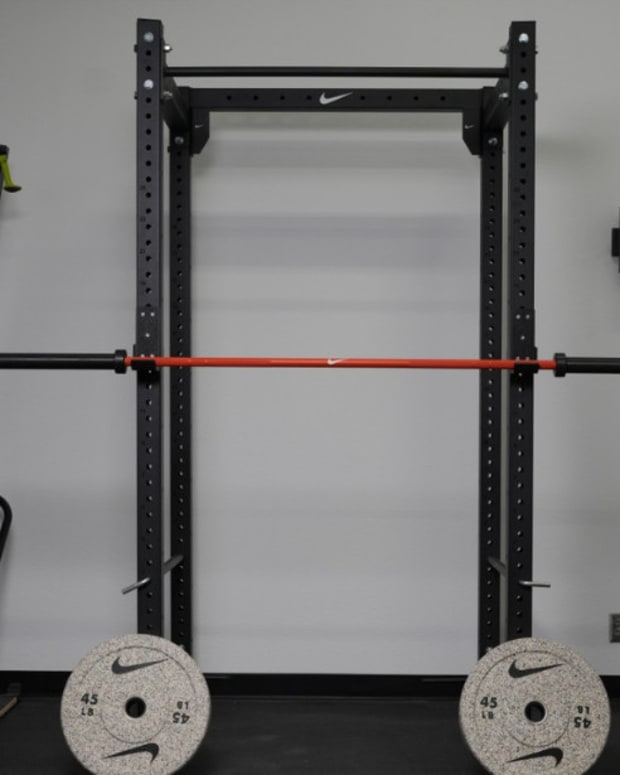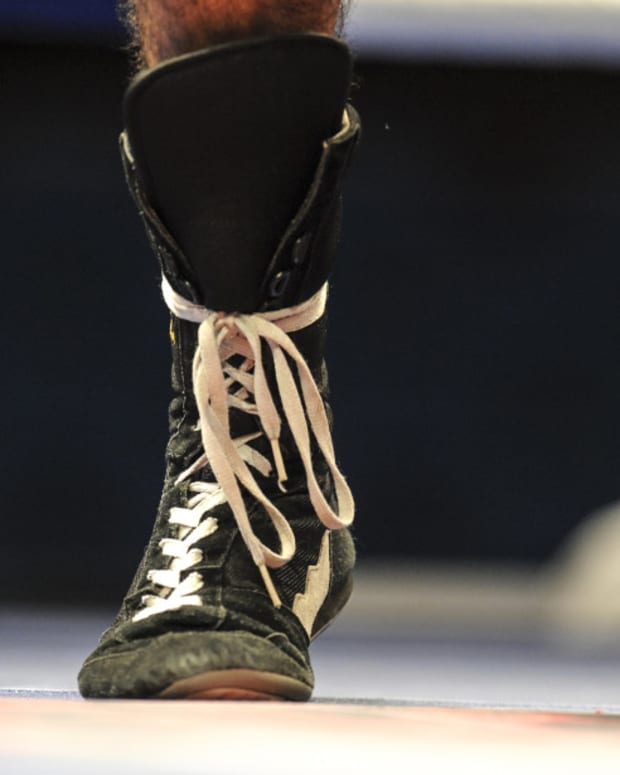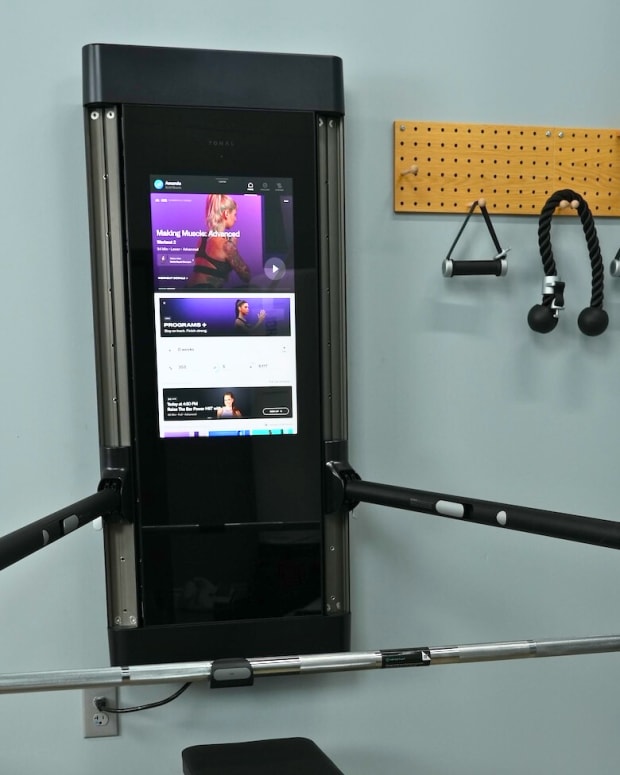The products featured in this article have been independently reviewed. When you buy something through the retail links on this page, we may earn commission at no cost to you, the reader. Sports Illustrated editorial staff are not involved in the creation of this content. Learn more here.
You may be as strong as an ox, but if you’re out of breath going to the grocery store, maybe it’s time to intersperse those deadlifts with some cardio.
Cardio, short for cardiovascular training, is aerobic activity which elevates your heart rate for a prolonged period of time. Think running, cycling or swimming, but if every tier of that triathlon trio fills you with dread, fear not! The types of cardio are limitless.
Incorporating cardio into your workout routine helps with weight loss, but that’s just one of the benefits. People that regularly do cardio workouts typically have a lower resting heart rate and lower blood pressure, and daily movement helps our mental health and helps you to sleep better, too.
The recommended benchmark of cardio per week (NHS guidelines) for a healthy adult is 150 minutes of moderate aerobic activity or 75 minutes of vigorous aerobic activity, but according to professionals, this may not be enough, especially if you’re looking to shift pounds. So how much cardio should you be doing, and which type to achieve the results you want? We’ve crunched the numbers and spoken to experts to give you the lowdown.
The products featured in this article have been independently reviewed. When you buy something through the retail links on this page, we may earn commission at no cost to you, the reader. The Sports Illustrated editorial team is not involved in the creation of this content. Learn more here.
Our Picks for the Best Cardio for Weight Loss:
- High Intensity Interval Training
- Rowing
- Elliptical
- Weight Training
- Cycling
- Running
- Jumping Rope
- Swimming
- Increase Daily Step Count
High Intensity Interval Training
Who it’s best for:
- Those who are at a more advanced fitness level
- You get bored easily
- You want to achieve maximum impact in a short space of time
- You want to target specific areas of your body
The beauty of High Intensity Interval Training (HIIT) is that it is so varied. If you hate an exercise, you’ve only got to do it for 30 seconds or so (and then however many times the circuit comes around), but it’s a great motivational tool to get you to work on exercises that you don’t like. Anyone can do something for 30 seconds!
HIIT is short periods of intense, high-impact work followed by short periods of rest. It means that you can target the part of your body that you want on any given day, or do a full body workout. Looking to tone up your quads? Do a HIIT workout that blasts this part of your body.
Tony Horton recommends incorporating at least one HIIT workout into your weekly training plan on a 30 seconds on/30 seconds off ratio. This ratio will “elevate the heart rate and put the body into fat-burning mode”.
Is it hurting? That’s normal, says Martin Sharp. “It should feel almost impossible to keep going,” Sharp says. “You’re at your peak performance heart rate, feeling out of breath and unable to talk. This helps you to gain many of the benefits of slower cardio over a long duration in a compressed space of time.”
Suggested workout by Alex Randall, founder and CEO of Revel Sports, a fitness blog and educational resource:
Warm up with five to 10 minutes of light cardio exercises, including jumping jacks and high knees.
For the main workout, complete three to four rounds of the following bodyweight exercises. Perform each exercise for 30-60 seconds (depending on your fitness level) with a 10-15 second break between each.
- Squats
- Lunges
- Push ups
- Burpees
Then complete two to four rounds of the following high intensity cardio exercises. Again, perform each exercise for 30-60 seconds with a 10-15 second break.
- Jumping jacks
- Mountain climbers
- Sprinting on the spot
- Cool down/stretch for five minutes to finish.
Rowing
Who it’s best for:
- You want to lose weight fast (it burns a lot of calories)
- You want to build muscle in your upper body, quads and calves
- You don’t mind repetition
You might mistakenly think that rowing is all about your arms, but done correctly, rowing is a full body workout which activates your quads, glutes and core, too. It uses 85 percent of the muscles in your body and activates nine muscle groups.
Rowing requires equipment. Most gyms will have a rowing machine, or you can invest in one to have at home. If you’re fortunate enough to live by the sea or by a lake, rowing in the open air has to be one of the most idyllic ways of incorporating cardio into your day. It can also come with a lot of camaraderie. Rowing teams (e.g. gig rowing) are a fantastic way to work as part of a club.
Rowing can also be a big calorie burner. Depending on your weight and the intensity of your workout you can burn up to 800 calories an hour.
Suggested workout by Dylan Rose:
Warm up with an 800 meter overhand grip at a moderate pace, followed by an 800 meter underhand grip at moderate pace. Underhand grip is useful for an enhanced bicep focus and increased stretch and range of motion.
For the main workout, complete 20 seconds of rapid fire rowing, followed by 10 seconds of slow and controlled rowing, focusing on regaining your breath. Repeat four times.
Elliptical
Who it’s best for:
- Beginners
- Anyone restarting exercise after a break
- Controlling the intensity of your workout
Done right, using the elliptical machine can be an effective, all-body cardio workout. It works your whole body, your glutes, hamstrings, quads, core, chest, arms and back. If you’re moving slowly and on a flat setting rather than an incline, though, your elliptical workout may not be as effective as you think, says Tony Horton.
“Three minutes on the elliptical at an incline and a fast speed followed by 30 seconds of rest, then three minutes of a weight training move etc. is better than a straight 30 minute elliptical workout,” says Horton.
It goes without saying that this form of cardio requires equipment, namely an elliptical machine. Choosing the right one from so many options out there can be a challenge—that's why we researched and found several that work equally well for beginners and athletes in our best elliptical machines roundup.
Suggested workout by Alex Randall:
Warm-up with five to 10 minutes on the elliptical at a moderate intensity.
Perform intervals by increasing the resistance and intensity for 30 seconds to one minute, then decreasing the intensity for one to two minutes. Repeat this for a total of 20-30 minutes.
Cool down for five to 10 minutes at a moderate intensity.
Weight Training
Who it’s best for:
- You want to lose weight while you’re resting (yes really, it increases your resting metabolic rate)
- You want to tone your muscles as well as losing weight
- Everyone—it’s hugely beneficial to mix up aerobic activities with weight training
Sometimes weight training gets dismissed when it comes to weight loss, but it shouldn’t be, and Tony Horton says it’s an integral part of a training program. Weight training will help you to burn more calories at rest.
“It produces an “after-burn” effect, technically referred to as Excess Post-Exercise Oxygen Consumption (EPOC),” says Horton. “This keeps the muscles revved up after exercise. Also, strength training with weights increases lean muscle mass which cuts through fat.”
In short, weight training might not burn as many calories per hour as going for a run, but the after-effects are substantial.
Suggested workout, by Martin Sharp:
Complete three sets of the following exercises, starting with 10 reps, then 12, then 15.
- Bent over rows
- Bent over single arm dumbbell rows
- Dumbbell 21s (bicep curls)
- Alternating single arm hammer curls
- Double arm dumbbell curls
Cycling
Who it’s best for:
- You’re looking for a low-impact form of cardio
- You prefer exercising with varying scenery
- You want to tone your legs
The great thing about cycling is that it gives you a leg workout, a low-impact workout and a calorie-burning workout all at once. In addition to the many different options for indoor cycling sessions, you can also start programs that take you through a variety of scenery, including winding through Chile's Andes.
When you consider things like electric bikes, cycling can become an expensive hobby, but if you're also using your bike for commuting, you'll save money on fuel/subway fares and overall time. In the long term, a bike can be a really good investment! Then indoor cycling bikes like WattBike and Peloton are a great solution if you want the same effects in the comfort of your own home.
Typically, cycling burns in the region of 400 calories an hour, although a spin class can torch up to 600 calories. That’s lower than, say, running or rowing, but you can do it for much longer. Cycling focuses primarily on your legs, and the largest muscle in your body, your glutes, which allows you to increase muscular endurance and tone up without compromising your joints.
Suggested workout by Dylan Rose, Personal Trainer & Behavior Change Coach:
Warm up with a two kilometer cycle at a low resistance, gradually increasing speed towards the end.
For the main workout, cycle all out for 20 seconds at medium resistance, then lower the resistance for 10 seconds. Repeat 10 times.
Reduce the resistance to low and pick up the pace for a five minute stretch. Slowly add resistance while maintaining your pace for another five minutes. The final 30 seconds should be a real effort.
Cool down by cycling for five minutes at a slow to moderate pace, reducing the resistance gradually to loosen up your legs and allow for maximum blood flow. This will prevent the dreaded aches the day after.
Running
Who it’s best for:
- You don’t have/don’t want a gym membership
- You enjoy the mental health benefits of training outside
- You want to burn a high number of calories fast
- You’re not bored by a repetitive movement
You only have to look at the lean bodies of endurance runners and sprinters to see that running is an effective way of shifting pounds and burning body fat. Running five miles an hour can burn upwards of 600 calories an hour, so athletes that run a half marathon or further will regularly find themselves doubling or tripling the amount of calories their body would burn in a day at rest.
Most people have a preference between endurance running and sprinting, and while there’s no "one type is better," Running Coach and INCUS advisor Lewis Moses recommends different styles to achieve different results.
“Slower, longer runs are better for losing weight and burning fat,” says Moses. “When training for longer events such as marathons or ultra-runs, runners will start to burn more fat. They use it as an energy source once their carbohydrate stores have been depleted.”
The equipment needed is minimal, just a good pair of trainers and proper running clothing. Think about the surface you’ll spend most of your time running on. If it’s asphalt, invest in road runners, or if you run on trails, buy a pair of trail runners.
There is a big buzz about fasted running, or running first thing in the morning before breakfast, but it isn't a quick fix to lose weight.
“The run itself may burn more fat, but you will in turn burn less fat overall in the day,” he says. “It’s important to maintain a good, balanced diet and continue to build a good relationship with the food you eat.” Rather than skipping breakfast, it seems that it's more important to eat a balanced and appropriate diet overall to support your runs.
Suggested workout for beginner runners, by Lewis Moses:
Run at 80-90 percent of your maximum effort for a short period of time and then stop to recover. This can be a walk or a slow jog, but it’s important to take the recovery time so that you can continue to repeat at faster intervals.
Jumping Rope
Who it’s best for:
- You’re time or space poor
- You want to improve your coordination and focus
- You want to burn a large amount of calories (fast)
- You want to tone your legs, bum and tum
Skipping is so accessible. You don’t need a gym membership. The only equipment that you need is a jump rope, and you don’t need much space either; a clear space in your living room or a small patch of garden will suffice. 10 minutes with a jump rope at a rate of 100 jumps a minute burns the same amount of calories as you’d burn running an eight minute mile, and you can burn up to 600 calories an hour.
Tony Horton, Celebrity Fitness Trainer and Founder of PowerLife says that it’s a highly effective form of cardiovascular training. “It’s not just about increasing your endurance, it improves your bone density and produces greater coordination and balance,” says Horton. “It requires the engagement of your quads, calves and buttocks as well as a steady, stable core to maintain balance.”
We didn’t realize we were doing a leg, bum and tummy workout when we were playing games with a jump rope in the elementary school playground.
Suggested workout by Jacqui Ward, Personal Trainer and Fitness Instructor:
Alternate between the following jump rope exercises:
- Basic jump
- Alternating foot jumps
- High knees
- Jump rope jacks
Complete each exercise for 45 seconds, giving yourself a 15 second rest between starting the next exercise. Repeat three times for a short sharp 12 minute workout.
Swimming
Who it’s best for:
- You want to take the pressure of your joints
- You’re suffering from an injury or repetitive strain, or respiratory problems like asthma
- You want all all-body workout
- You’re looking to manage stress and/or sleep better
Each swimming stroke works different muscle groups, so you can mix up your workout between backstroke, breaststroke, crawl and butterfly for an all body workout. Even at rest (treading water) you’ll be toning and burning calories.
Swimming can be relaxing (breaststroke) or super high intensity. An hour of butterfly stroke can burn around 900 calories. It also doesn’t put as much stress on your joints as many other forms of cardio. You’re still elevating your heart rate, but with less risk of getting injured or getting the kind of repetitive strain injuries that often plague runners.
Open water swimming (or "wild swimming") is increasingly popular and comes with fantastic benefits to mental health. Studies found that the effects of cold water swimming on moods were instantaneous, leading to “an immediate improvement in mood following each swim.”
The obvious downside to swimming is accessibility. If you live by a lake or the ocean, lucky you! Pool memberships vary in price, so whether or not this is the right form of cardio for you may depend on local facilities.
Suggested workout by Lucy Campbell, CrossFit coach/athlete and Fittest Woman in the UK 2022:
Warm up with 200-400 meters of mixed strokes/modalities.
For the main session, complete:
- One 400 meter swim, then 30 seconds rest
- Two 200 meter swims, then 45 seconds rest
- Four 100 meter swims, then 60 seconds rest
Repeat two to three times for more advanced swimmers.
Increase daily step count
Who it’s best for:
- You don’t like cardio
- You experience pain from high intensity activities
- You’re recovering from an injury
- Literally everyone
The recommended number of daily steps is 10,000, but in our busy, modern lives where many of us work from home or have a non-active commute, how many of us actually achieve that? Not many, it would seem, and the number of steps that the average person in the U.S. takes each day is less than half that, between 3,000 and 4,000.
The health benefits of walking may make it the most underrated form of cardio. “Walking stimulates most of the 650+ muscles in your body and is accessible to most people wherever they are,” says Martin Sharp, a Multi-Award Winning Personal Trainer, Fitness Coach and founder of Sharp Fit For Life. “Working on how you walk to ensure you have correct alignment in your gait, you’re comfortable and maintaining correct posture, also improves your ability to continue to benefit from this exercise, mile after glorious mile.”
It’s also incredibly adaptable. The number of calories burned through a leisurely stroll hovers at around 200 per hour, but if you’re trekking on steep inclines and carrying a heavy backpack, this shoots up to 500+ calories an hour.
Numerous health studies have proven that getting outside for a walk impacts positively on your mental health, so ditching the car in favor of a walking commute won’t just help you to lose weight, it can lift your mood too.
Suggested workout:
Download the Walking For Weight Loss app, which tailors plans to your fitness levels.
Is Cardio Necessary for Weight Loss?
Cardio is not essential for weight loss, but you’ll likely struggle to lose weight without it. For weight loss to happen, you need to be in a calorie deficit. You can achieve this by adapting your diet or by purely strength training, but since cardio tends to burn more calories, it speeds up the process considerably.
“Cardio is more effective at burning calories as you will tend to work more continuously for longer periods which makes it easier to be in a caloric deficit,” says Lucy Campbell. She suggests incorporating both cardio and strength training for a healthy routine, but the ratio should depend on what you can stick to.
How does cardio contribute to fat loss?
Firstly, by helping us to lose weight. Losing weight through sustained exercise will naturally result in a loss of fat, although this is far from the only benefit. “It improves our cardiac and respiratory functions,” says Sharp, “as well as our endurance and oxygen utilization efficiency.”
Difference between weight loss vs fat loss
You can be a healthy weight without having muscle definition. Think about what your goals are. If your BMI is overweight (over 25) you may want to start by losing weight to bring yourself within a healthy range (18.5-25). If you’re already a healthy weight, but have stubborn belly fat or areas that you’d like to target, then you’re probably more focused on losing fat.
Cardio and strength training both help with fat loss, but you can only lose weight if you’re in a calorie deficit.
How To Choose the Right Cardio Workout for You
Consider your needs
The short answer is: do what works for you and your goals. Looking to build muscle definition in your arms and shoulders? Rowing or weight training could be best for you. Or perhaps you’re more motivated by training in a group? Sign up for HIIT classes or join a running club.
Be mindful of your schedule
There’s no right or wrong time to work out, so don’t force yourself to go for a run before breakfast if it’s not your natural rhythm. Be wary of working out on an empty stomach if you’re not used to it, since there’s no proof that this burns calories quicker.
Find out what you enjoy most
If you enjoy something, you’ll want to continue with it and push yourself further. If you’re someone who hates running, there’s no point in forcing yourself to bust out five miles each day. Take up something that you like doing instead, and don’t be afraid to experiment until you find the right workout style and exercise for you. The types of cardio listed here are a good starting point, but the possibilities are endless. Use your natural surroundings. If you live by the mountains you might want to start skiing or climbing, or if you’re by the water, swimming, kayaking or surfing. If you live in a city, you could even consider joining a local parkour group.
Cardio for Fat and Weight Loss FAQs
Does cardio burn belly fat?
Yes! When you lose weight, the easiest and usually first place where you lose it is your belly. The first to go is white, visceral fat which sits around your midriff, and this is also the most harmful place to store fat. To lose this, you’ll want to be in a calorie deficit, which is achieved through all forms of cardio (aerobic) exercise. To create muscle definition, you may want to add in abdominal exercises, too. The old saying that “abs are made in the kitchen” rings true, though. “It largely comes down to your diet,” says Lucy Campbell.
Is 30 minutes of cardio a day enough?
It depends on your current activity levels and goals. If you’re getting the recommended 10,000 steps a day, you’ll naturally be incorporating cardio into your daily routine, but that doesn’t mean that you can’t do more. Don’t beat yourself up if you haven’t had time to squeeze in 30 minutes of cardio—those days happen, and we all get slammed at work sometimes.
Campell recommends three to five cardio (aerobic) sessions a week as a benchmark. “If you’re starting from scratch, it’s important to build that up gradually,” she says.
Is cardio better in the morning or at night?
Do what works for you. The key is making sure that you’re motivated and enjoying what you’re doing. If you’re energized in the morning, work out then, but if you’re more of a night owl, then the effects won’t be any different if you work out in the evening (though you may have a more difficult time winding down for sleep).
Also, remember that the old wives’ tale about working out on an empty stomach burning more calories is a myth, says Lucy Campbell. “It’s not true that you’ll burn more fat by exercising in the morning prior to eating,” says Campbell, “so if you’re hungry beforehand, eat!”
Should I focus on weights or cardio for weight loss?
Both. A balanced training plan should include strength training and cardio. Strength training doesn’t necessarily have to include weights and can be bodyweight exercises if you don’t have equipment, but including “weighted training will help you to build lean muscle mass faster,” says Tony Horton. More lean muscle mass will increase the number of calories that you can burn at rest.
If you haven’t got a gym membership and don’t want to invest in dumbbells, you can use household objects to train. Even cans of beans can work well as a substitute for lightweight dumbbells.
Related Post: The Best Cardio Machines for Weight Loss
Final Thoughts
Experts advise mixing cardio and strength training to achieve and sustain weight loss, but don’t forget that weight loss will be impossible if you’re not in a calorie deficit (although you’ll still see plenty of benefits from regular exercise). The key is making your workout enjoyable and in line with your schedule; that way, you’ll be less inclined to skip it.
Prices are accurate and items in stock as of publish time.


















